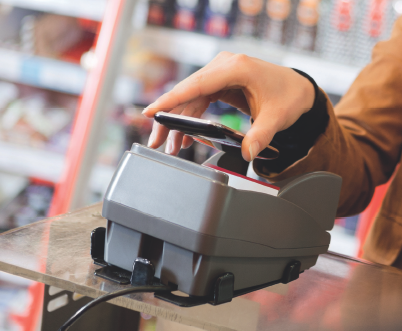
A new opportunity
Most people have their smartphones within an arm’s reach throughout the day. Ever since gadget manufacturers began making them with NFC capabilities, consumers have excitedly embraced ways to pay that don’t require reaching for cash or a card.
Data published by MasterCard indicates that almost 90 percent of in-person global transactions1 occur at merchants that offer contactless technologies. Another finding from the study was that 84 percent of consumers want to pay when and how they prefer. NFC technology makes that possible.
Although many NFC payments happen via smartphones, Starbucks took another approach. The coffee brand released a pen preloaded with funds2 people can use to pay for drinks or other merchandise. Before that, Starbucks created an NFC-enabled handbag that people could win through a lottery drawing.
NFC technology also supports merchants that want to roll out contact-free payments with limited existing infrastructure. For example, one offering lets Romanian shopkeepers convert their smartphones or tablets3 into point-of-sale (POS) readers with a software-based solution.
NFC tags help retailers analyze how customers use products
Getting products into customers’ hands is only half the battle in retail. It’s also necessary to effectively manage the reverse logistics processes stemming from customers returning items and requesting refunds. Statistics show that approximately $1 million in returns can cause a $500,000 reduction in potential profitability4.
Retailers must also often set aside dedicated space for returns and hire more people to process the goods. Those are some of the reasons why many stores allow customers to keep unwanted products rather than sending them back. However, using NFC technology in retail could give brands better insights into product usage, including the possible reasons for returns.
In one instance, an outdoor goods retailer embedded NFC tags directly into water skis and wakeboards5 before selling them. Brand representatives can also make them display multiple capabilities. Besides showing customer usage statistics, these NFC innovations could tell customers about local offers or provide sales representatives with customized messaging that steers in-person shopper interactions.
NFC technology can curb counterfeiting
Amazon has had a major influence in pushing other commerce brands to step up supply chain resilience efforts. For example, it utilizes third parties along the supply chain6 to speed order fulfillment. The company also lets third-party sellers engage with customers through its Marketplace. However, interactions with outside entities raise the risk of counterfeiting.
 Amazon recently published an extensive report about its activities to address counterfeit products and protect purchasers. For example, the company detected, seized, and destroyed more than two million products7 that ended up in distribution centers before they reached customers. This concentrated effort against counterfeiting has received a more than $700 million investment so far.
Amazon recently published an extensive report about its activities to address counterfeit products and protect purchasers. For example, the company detected, seized, and destroyed more than two million products7 that ended up in distribution centers before they reached customers. This concentrated effort against counterfeiting has received a more than $700 million investment so far.
News of this project does not specifically mention near-field communication. However, earlier coverage elsewhere highlighted the potential for NFC tags to reduce fake product issues. A whitepaper published by chip manufacturer ST Microelectronics discussed how some versions feature digital signatures that verify8 the authenticity of goods passing through each part of the supply chain.
Using NFC technology in retail could encourage customer transactions
Retailers make ongoing efforts to urge people to increase their transaction sizes during visits. Succeeding in that aim could increase profitability and show people that their favorite brands are well-equipped to meet their needs. Some retail brands use NFC technology to help customers get more acquainted with offerings.
For example, Apple is reportedly working on a plan involving NFC tags that give people targeted notifications9 while in the brand’s retail outlets. More specifically, it highlights offerings on services such as Apple TV+ and Apple Music. However, the NFC tech would not merely encourage people to launch those apps. Instead, it would recommend content from those Apple services. Those alerts could get more people interested in signing up for Apple subscription products they can enjoy on new devices.
In another case, Dutch clothing brand G-Star RAW launched a campaign where people can use their phones to scan NFC tags and learn more about garments10 showcased in window displays. Passersby can get details about sizes, colors, and prices. Even better, the data shown on their phones includes inventory data for the products in the store or on the brand’s website. Getting information like that could turn people’s spontaneous interest into purchases.
Applying NFC technology in retail can ease pain points
These examples show why retailers should strongly consider using NFC technology to address known challenges. Doing so can pay off for everyone involved. For example, tag data can help retailers increase customer satisfaction and purchase frequency. Then, shoppers are more likely to choose those stores for current and future needs.
Making the most of NFC technology requires interested retailers to determine the biggest challenges they hope to overcome. Then, they can see which NFC solutions exist and explore the most effective ways to implement them for maximum adoption.
Emily Newton
Emily Newton is the Editor-in-Chief of Revolutionized, an online magazine exploring how technology is changing our world.
Subscribe or follow her on LinkedIn for more of her articles.
https://www.linkedin.com/in/emily-newton-revolutionized/
https://revolutionized.com/author/emily/
1 https://www.businesswire.com/news/home/20210503005823/en/Mastercard-New-Payments-Index- Consumer-Appetite-for-Digital-Payments-Takes-Off
2 https://www.theverge.com/2019/9/18/20871830/starbucks-japan-touch-nfc-pen-announced
3 https://www.retailcustomerexperience.com/news/romanian-merchants-turn-nfc-phone-intocontactless-pos-terminal-2/
4 https://revolutionized.com/what-are-the-best-reverse-logistics-strategies-for-peak-season/
5 https://learn.gototags.com/articles/radar-skis-builds-direct-to-customer-communication-withembedded-nfc-tags
6 https://prostack.com/2019/01/14/6-ways-amazon-is-changing-supply-chain-management/
7 https://www.aboutamazon.com/news/company-news/amazon-brand-protection-report
8 https://www.nfcw.com/2019/09/20/364446/st-explains-how-nfc-tags-with-digital-signatures-canprovide-end-to-end-protection-against-counterfeiting-throughout-the-supply-chain/